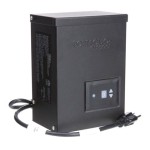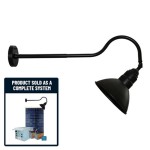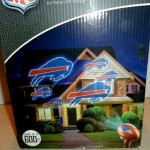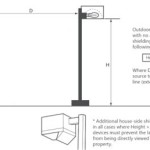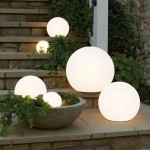Homemade Outdoor Light Fixtures For Home
Outdoor lighting significantly enhances a home's curb appeal, security, and usability. Professionally installed or mass-produced outdoor lighting can be costly. A cost-effective and personalized alternative is creating homemade outdoor light fixtures. These fixtures offer a unique aesthetic, tailor-made to complement the home's architecture and the homeowner's personal style. Furthermore, constructing these fixtures from scratch or repurposing existing materials promotes sustainability and resourcefulness.
Several factors must be considered before embarking on a DIY outdoor lighting project. These include weather resistance of materials, electrical safety, and compliance with local building codes. Careful planning and execution are paramount to ensure the fixtures are both functional and safe for long-term outdoor use.
Material Selection and Weatherproofing
Choosing the right materials is fundamental to the longevity of homemade outdoor light fixtures. Materials must withstand exposure to various weather elements, including rain, snow, sunlight, and temperature fluctuations. Untreated wood, for instance, is susceptible to rot and insect infestation if used outdoors. Metal components can corrode if not properly protected with rust-resistant coatings.
Suitable materials for building robust outdoor light fixtures include pressure-treated lumber, cedarwood, various types of metal like aluminum and stainless steel, and durable plastics. Pressure-treated lumber is chemically treated to resist decay and insect damage, making it a reliable option for structural components. Cedarwood contains natural oils that repel insects and resist moisture, rendering it a desirable choice for aesthetically pleasing fixtures. Aluminum and stainless steel are inherently resistant to corrosion, making them ideal for mounting brackets and other hardware that will be directly exposed to the elements.
Weatherproofing is an essential step, regardless of the materials selected. For wooden fixtures, applying several coats of exterior-grade paint or sealant can significantly prolong their lifespan. Paint provides a protective barrier against moisture, while sealant fills in cracks and prevents water penetration. Metal fixtures benefit from the application of a rust-resistant primer followed by a topcoat of exterior paint. Any exposed wiring or electrical connections must be housed in waterproof enclosures to prevent electrical hazards. The use of weatherproof caulk around joints and seams further enhances the fixture's resistance to water intrusion.
Consider the type of light source when selecting materials. If using incandescent or halogen bulbs, ensure that the fixture can withstand the heat generated by these bulbs. LEDs are generally a better choice for outdoor lighting due to their energy efficiency, long lifespan, and low heat output. LED bulbs are also available in a wide range of colors and brightness levels, providing greater flexibility in design.
Repurposing existing materials is a sustainable and cost-effective approach to building outdoor light fixtures. Old mason jars, for example, can be transformed into charming lanterns. Discarded metal pipes can be used to create industrial-style sconces. Even broken glass can be incorporated into mosaic designs for unique and eye-catching light features. When repurposing, ensure that the materials are cleaned and prepared appropriately before use. Remove any sharp edges or hazardous substances, and apply necessary coatings to protect against weather damage.
Electrical Safety and Installation
Electrical safety is paramount when working with outdoor lighting. Improperly installed electrical fixtures can pose a serious risk of electric shock or fire. It is essential to follow all applicable electrical codes and regulations, and to consult with a qualified electrician if uncertain about any aspect of the installation process.
Before beginning any electrical work, ensure that the power to the circuit is turned off at the main breaker panel. Use a voltage tester to verify that the circuit is de-energized. Wear appropriate personal protective equipment, such as insulated gloves and safety glasses.
Use only outdoor-rated electrical wiring and components. These components are designed to withstand exposure to moisture and sunlight, and they are typically labeled with the marking "UL Listed for Wet Locations." Properly ground all metal fixtures to prevent electric shock. Grounding involves connecting the metal fixture to a grounding conductor, which provides a safe path for electrical current to flow in the event of a fault.
All electrical connections must be made inside weatherproof enclosures. These enclosures protect the connections from moisture and prevent short circuits. Use weatherproof wire connectors to ensure secure and watertight connections. Avoid using standard wire nuts, as they can loosen over time and allow moisture to enter the connection. Consider using a GFCI (Ground Fault Circuit Interrupter) outlet for outdoor lighting circuits. A GFCI outlet will automatically shut off the power if it detects a ground fault, which can help prevent electric shock.
When running electrical wiring underground, use direct-burial-rated cable. This type of cable is specifically designed to be buried directly in the ground without the need for conduit. Bury the cable at least 18 inches deep to protect it from damage. Use a trenching tool or shovel to create a trench, and backfill the trench with soil after the cable has been installed.
Securely mount the light fixtures to a stable surface, such as a wall, post, or deck. Use appropriate mounting hardware that is rated for outdoor use. Ensure that the fixtures are level and properly aligned. Conceal any exposed wiring to improve the appearance of the installation and prevent damage to the wiring.
Design Considerations and Aesthetic Appeal
The design of homemade outdoor light fixtures should complement the overall aesthetic of the home and landscape. Consider the style of the home, the surrounding environment, and the desired effect when designing the fixtures. The light fixtures should be both functional and visually appealing, enhancing the beauty and usability of the outdoor space.
Different types of light fixtures serve different purposes. Path lights are used to illuminate walkways and driveways, providing safety and security. Spotlights are used to highlight architectural features or landscape elements. Floodlights are used to illuminate large areas, providing security and deterring intruders. Sconces are decorative light fixtures that are mounted on walls, adding ambiance and style to outdoor spaces. Lanterns are portable light fixtures that can be hung from trees or posts, creating a warm and inviting atmosphere.
Consider the color and intensity of the light emitted by the fixtures. Warm-toned light (e.g., 2700K-3000K) is generally preferred for outdoor lighting, as it creates a cozy and inviting atmosphere. Cool-toned light (e.g., 4000K-5000K) can be used for task lighting, such as illuminating a work area or security lighting. The intensity of the light should be appropriate for the intended purpose. Avoid using excessively bright lights, as they can create glare and disrupt the natural environment.
Incorporate natural elements into the design of the light fixtures. For example, use driftwood or stones to create unique and rustic fixtures. Plant climbing vines or flowers around the fixtures to soften their appearance and integrate them into the landscape. Use recycled materials creatively to add character and charm to the fixtures. Mason jars can be used as shades, old metal tools can be incorporated into brackets, and reclaimed wood can be used to build bases.
Consider the use of shadows and silhouettes to create interesting visual effects. Position the light fixtures to cast shadows on walls or pathways, adding depth and dimension to the outdoor space. Use stencils or cutouts to create decorative patterns on the fixtures, projecting unique designs onto the surrounding surfaces. Experiment with different materials and textures to see how they interact with light, creating dynamic and captivating effects.
Integrating smart technology into homemade outdoor light fixtures can enhance their functionality and convenience. Install motion sensors to activate the lights automatically when movement is detected, providing security and saving energy. Use timers to schedule the lights to turn on and off at specific times, creating a more automated and efficient lighting system. Connect the lights to a smart home system, allowing them to be controlled remotely via a smartphone or voice assistant.
Finally, consider the environmental impact of the outdoor lighting. Use energy-efficient LED bulbs to minimize energy consumption. Choose materials that are sustainably sourced and environmentally friendly. Avoid excessive lighting, as it can contribute to light pollution and disrupt the natural environment. Opt for lighting designs that minimize light trespass and direct light only where it is needed.

Set The Mood With Outdoor Lighting

Mason Jar Light Fixture Crafts Love

21 Best Outdoor Lighting Ideas Easy Patio

10 Best Outdoor Lighting Ideas Landscape Design Secrets A Piece Of Rainbow

43 Diy Patio And Porch Decor Ideas Outdoor Chandelier

19 Stylish Outdoor Lighting Ideas The Best Patio

Easy Diy Outdoor Light Lighting Chandelier

18 Stunning Diy Outdoor Lighting Ideas

Home Decorators Collection Blakeley 19 25 In Transitional 2 Light Black Outdoor Wall Fixture With Clear Beveled Glass 19905 The Depot

How To Install Outdoor Lighting And Diy Family Handyman
Related Posts
